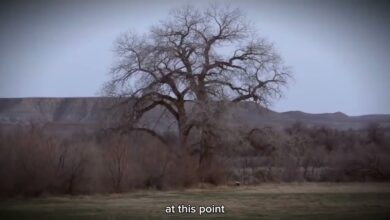Terrifying Discovery At the Mesa (Skinwalker Ranch)
Terrifying Discovery At the Mesa (Skinwalker Ranch)

A strange discovery in the mesa, drilling, green jelly, and an ancient wetland beneath Skinwalker Ranch.
For more than a month, the investigative team at Skinwalker Ranch has been locked in a stubborn, grinding standoff with the mesa. Every day begins with optimism and ends with exhaustion—the kind of fatigue that sets in only when the land itself seems to push back.
On paper, their mission is clean and procedural: drill two 8-in bore holes from opposite sides of the mesa, converging near the position where ground penetrating radar traced the unmistakable outline of a massive dome-shaped anomaly buried deep within the rock.
That object, first detected in 2021, has refused to let them forget its presence. Its radar cross-section betrays a metallic structure with characteristics eerily similar to aerospace-grade protective alloys—materials NASA once used on spacecraft to shield them against extreme temperatures and micrometeorite impacts.
The dome isn’t alone. Additional radar sweeps revealed a constellation of smaller anomalies encircling it, forming a cluster that feels less like random geology and more like the footprint of a buried installation—or the shattered remains of something catastrophic.
Whether these secondary structures are fragments, supports, or entirely separate objects remains a blank on their charts—a blank the team is determined to fill by drilling two access points.
The goal is simple: thread scanning instruments directly into the heart of the mesa. If successful, they would finally have eyes inside the anomaly’s perimeter—thermal imaging, spectrometric readings, realtime structural maps, maybe even a look at the surface of the dome itself.
After years of speculation, they might finally learn if the object is natural, manufactured, or something far stranger.
Yet, the Mesa has responded as if it wants the secrets to stay buried.
From the moment drilling began, the team found themselves caught in a cascade of phenomena that defy logic. Signals from equipment flickered inexplicably. A precision beacon meant to track the drill bit underground began jumping across frequencies like it was fighting interference from an unseen source.
Machinery that normally chews through stone stalled as if hitting invisible resistance. Spoils pulled from the bore hole contain substances that should not exist inside solid sandstone—gelatinous green and pink material, fragments of ancient aquatic plants, and traces of burned organic matter sealed within the rock.
Every day brings another variable, another anomaly, another clue that refuses to sit neatly inside the boundaries of conventional geology. The deeper they dig, the more the mesa behaves like something aware of their presence—something that has been waiting.
Signals gone wild — the beacon chaos
As the drillers pulled each rod free for inspection, the team kept a close eye on the tracking beacon embedded near the drill bit. The device is designed to be one of the most reliable elements of the entire operation—a steady, unwavering broadcast that pinpoints the bit’s position even through hundreds of feet of stone.
And for most of the borehole, it behaved exactly as expected. The signal was crisp, clean, and consistent.
Then the bit reached the depth where they believed the dome-shaped anomaly sat. In an instant, the beacon’s behavior changed. The steady tone fractured. The frequency began to jump wildly, ricocheting between readings as if something were grabbing the signal and twisting it.
Data flickered in and out. Coordinates vanished from the display. At moments, the beacon reappeared yards from where it had been seconds earlier, only to blink out again as if erased mid-transmission.
This kind of disruption doesn’t happen underground—not without a cause. These beacons are built to operate inside dense rock under extreme pressure. They do not drift, skip, or distort unless subjected to powerful interference.
Something inside the mesa was interfering.
Down at the bore hole, the drillers felt the shift before anyone else did. The clay, previously soft and uniform, suddenly fought back. The bit began to grind with an unnatural resistance. The machinery labored as if it were being forced into something denser than the surrounding geology.
The rig shuddered. The operator’s hands tightened on the controls. Every instinct told them they were pushing against more than Earth.
As the signal collapsed into chaos, the team realized they had lost track of the drill head entirely. They were drilling blind—unable to confirm the trajectory, the depth, or even whether the bit was still intact.
Under normal circumstances, this level of uncertainty would be an immediate order to stop all operations. Yet the strange interference, the shifting resistance, and the erratic beacon suggested one thing very clearly:
Something inside the mesa was reacting to their presence.
And the mesa was only beginning to reveal its secrets.
Green jelly in the spoils pit
After clearing out the spoils pit with the suction system, the team spotted something that didn’t belong—an odd green lump resting among the clay and crushed stone.
At first glance, it looked like a mineral inclusion. Maybe a copper-rich deposit or a stained fragment of shale. That assumption lasted only a second.
When Bryant reached down and pinched it between his fingertips, the piece collapsed. It didn’t crumble. It squished.
What they held was gelatinous, bright green, semi-transparent—smooth like silicone, but softer, almost organic. It shimmered with a moist sheen under the sun, the kind of texture that looked wrong inside a mesa made of compacted sandstone and ancient clay.
Nothing in the drilling process could have generated it. The mud system produced no such substance. The equipment had no reservoir or coating that could break down into neon-colored jelly.
Then more of it appeared.
Small clumps surfaced as they sifted through the slurry. Some were firmer, others soft enough to smear. The color was consistent—until the next surprise emerged: a pink version of the same gelatinous material, pale and almost fleshy in tone, as if the mesa had two distinct layers of the same impossible substance buried within it.
Both varieties shared the same strange semi-transparency, the same unnatural recoil when pressed. Whatever this material was, it had no geological reason to exist inside solid sandstone.
The crew fell silent. Even the skeptics had no quick explanation.
Eric reacted first—snapping into protocol mode. He ordered bags, gloves, and airtight containers. Every piece needed to be preserved, cataloged, and sent to the lab before it degraded or reacted with air.
Speculation came in low voices: a mineral deposit no one recognized, a biological residue from something long extinct, a chemical byproduct of some ancient process, a manufactured substance.
Yet with every guess there was an unspoken understanding: nothing in nature or engineering they knew matched this material.
The mesa had already resisted their drilling. It had messed with their equipment and hid a metallic structure inside its heart. Now it was offering up something far stranger—something that looked, felt, and behaved like biological matter that had no business being there, sealed for thousands of years.
The ranch had always felt mysterious. In this moment, the mesa felt aware—as if it were revealing its secrets in deliberate, uncomfortable increments.
A carved piece of wood 200 feet inside the mesa
Then came the most startling find of the day—a discovery so out of place that for a moment the entire team forgot about the green jelly resting in the spoils, half-caked in mud and clay.
It was a piece of wood. Real, structured wood—not driftwood washed in by ancient water, not a twisted root from vegetation above.
This piece was shaped. Its edges bore the unmistakable marks of tools—straight cuts, flattened surfaces, a bevel that hinted at deliberate workmanship rather than the chaotic fractures of nature.
It looked like a fragment of lumber, something carved or machined by human hands long before it ever found its way into the depths of a sandstone mesa.
That alone rewrote every assumption about the geology of the site.
There are no known tunnels in that section of the ranch. No mining claims, no documented construction, no stories, no local rumors, no historical footnotes that point to any kind of excavation or subsurface activity.
The mesa should have been a sealed, untouched geological formation layered over millions of years. Yet here was a crafted wooden artifact buried nearly 200 ft inside solid rock.
Travis knelt beside it, brushing away the debris with slow, careful strokes. Whatever this thing was, it didn’t drift in through a crack or fall into a cavity. It had been trapped—sealed in by time, pressure, and sediment.
He set it aside gently, understanding immediately that this wasn’t just another anomaly. This was evidence—physical evidence—that something once existed inside the mesa long before anyone on the ranch arrived to investigate.
Something capable of shaping wood with tools.
Combined with the dome-shaped metallic object, the strange smaller anomalies, the electromagnetic interference, and the biological-looking jelly, this wooden fragment changed the conversation.
The mesa wasn’t just hiding an object. It was hiding history—a history no one had written down. A history that left behind strange metals, shifting energies, and now the unmistakable remnants of constructed material.
Whatever they were drilling into, it wasn’t just geology. It was a buried story—one that the mesa had held tight for centuries.
Enter Dr. Power — the scientific breakdown
With the strange samples secured, the team contacted Dr. Power of the University of Utah, a researcher known for his ability to identify obscure paleobotanical structures and trace ancient environments through microscopic clues.
When his face appeared on the screen, the lab equipment behind him humming quietly, the room at the ranch fell silent.
They had been chasing strange signals, metal anomalies, and inexplicable interference for weeks. But this was the first time they were handing something tangible—something from inside the mesa—to a scientist with no ties to the ranch.
They hoped for clarity. Instead, they received revelations.
Sample One — The Wood
Dr. Power lifted the first sample in a small vial, turning it in the light. At a glance, it still looked like a sliver of weathered lumber.
He placed it under a digital microscope, the image blooming across the monitor in crisp detail. What the magnification revealed immediately challenged every assumption the team had made.
The structure inside the fragment was riddled with carefully spaced pores—not fractures, not insect trails—true biological pore spaces arranged in patterns that belonged only to a very specific type of organism: aquatic plants.
Species that grew in shallow water, relying on spore chambers inside their stems to reproduce.
The piece they had assumed was worked wood, possibly a forgotten artifact, was actually the fossilized stem of an ancient aquatic plant—far older than any human habitation in the region.
The team fell quiet. The implication settled in like a weight on the table.
If a fragment of aquatic plant life was buried 200 ft within the mesa, then at some point in deep prehistory, an entire wetland existed inside what is now solid rock.
Not a temporary pool, not a rain-fed basin—a full wetland environment complete with plant life, sediment layers, and organic debris buried by geological forces over millions of years. A prehistoric environment sealed in stone.
Dr. Power explained that such preservation only happens when a landscape collapses or becomes rapidly encased, trapping organic material under layers of sediment. Over time, pressure fossilizes the debris, turning stems, leaves, and spores into hardened relics of a world long erased.
That meant the drill had punched through a forgotten ecosystem—an ancient wetland that had not seen light since before humans walked North America.
The scientific value of that alone was enormous.
Yet something didn’t sit right. Travis leaned forward, his brow furrowed. The plant stem looked fossilized, yes, but the piece still carried shapes and edges no natural wetland should produce.
The angles were too straight, the form too rectangular—almost as if that fragment had been broken from something shaped long after the plant had fossilized.
A fossil inside a structure—a plant preserved within something shaped by intention.
The thought hung unspoken, but everyone felt it.
The mesa wasn’t just hiding geology. It was hiding layers of history that didn’t line up—prehistoric biology pressed against modern interference and metallic anomalies that behaved like intelligent constructs.
The discovery of the ancient wetland should have closed the case neatly. Yet the team felt it did the opposite. It opened doors they didn’t want to think about.
Sample Two — The Green Jelly
The jelly sample left Dr. Power visibly unsettled. Even through the video call compression, the team could see the moment his expression shifted from curiosity to confusion.
He admitted immediately that the substance made little sense. It didn’t fit the geology of the region. It didn’t resemble any known sedimentary byproduct, and its coloration—bright green in some pieces, pink in others—was not biologically driven.
Under the microscope, the story became stranger. No chlorophyll, no algal filaments, no microbial mats, spores, or cellular structures.
Whatever this jelly was, it was not living tissue, not fossilized organic matter, and not a chemical that typically forms in sandstone formations.
Its texture and transparency suggested something engineered or altered, though Dr. Power hesitated to speculate.
To study it properly, he dissolved the gelatinous material in solution to isolate solid particulates suspended inside. The organic matrix melted away like thin resin exposed to solvent.
What remained at the bottom of the slide stunned him—fine, dark fragments, brittle, carbonized, unmistakable burnt botanical material.
Charred remains of plants—and not just a trace. High concentrations enough to indicate a significant combustion event.
He looked up at the camera, adjusting his glasses as if hoping the notes on his desk would offer a different interpretation. They didn’t.
The only logical conclusion was the one the team least expected:
Something caused a fire inside the mesa.
Not on its surface, not in an open cavity, not in a place reachable by air or ignition—a fire inside compacted stone inside the remains of a prehistoric wetland sealed for millions of years.
There is no natural geological mechanism that produces isolated pockets of burned plant matter deep inside sandstone. Lightning cannot strike hundreds of feet below ground. Volcanic activity leaves a very clear mineral signature, and none was present.
There is no known process where plant material fossilizes and then burns afterward without a source of oxygen.
No miner’s lantern, no human activity, no historical digging, nothing from any period of human settlement explains it.
And layered over this bizarre burn event were the other realities the team had confronted: the dome-shaped metallic object, the smaller anomalies surrounding it, the electromagnetic interference that crippled the drill’s tracking beacon, the jelly itself behaving like nothing organic or geological.
The presence of fire inside the mesa suggested an event violent, contained, and ancient—something powerful enough to ignite plant life inside a sealed environment without oxygen readily available and leave behind a residue that still told its story millions of years later.
The mesa was no longer just a geological puzzle. It was a crime scene frozen in deep time—a sealed vault holding evidence of an event no natural process could produce.
Whatever happened inside that mesa was deliberate—or catastrophic.
And the team had just drilled straight into the aftermath.
A growing puzzle beneath the mesa
With every attempt to drill deeper, the mesa reacts as though it has intentions of its own. It behaves less like stone and more like a living system defending itself.
Electromagnetic bursts scramble tracking signals. Mechanical resistance spikes without warning, as if the bit is pushing against something far denser than rock.
Strange materials rise from the spoils—gelatinous masses with no known geological or biological equivalent; fragments of prehistoric aquatic plants entombed impossibly deep within sandstone; and charred botanical remnants that speak of a fire no natural force could have ignited in a sealed, oxygen-poor environment.
Each discovery builds upon the last, forming a picture that refuses to settle into anything ordinary. It points toward a deeper, far more complex narrative hidden beneath Skinwalker Ranch.
Something ancient is down there—embedded in the earth long before modern geology shaped the mesa.
Something interacted with its surroundings in a way that left both environmental scars and technological fingerprints.
Something that created heat and fire in a chamber that should never have allowed combustion in the first place.
And whatever that something is, it remains capable of affecting the present—distorting frequencies, disrupting machinery, and deflecting tools designed to cut through stone as though they were brushing against the hull of a buried engine.
The dome-shaped anomaly that first drew the team’s attention now feels less like a standalone artifact and more like the upper surface of a larger structure—a system, a chamber, a vessel, maybe even the remains of something that didn’t originate here at all.
The smaller anomalies surrounding it line up like components radiating out in a pattern that suggests engineering rather than coincidence.
Machine, habitat, crash site—something older, stranger, and not bound to the rules of the natural world.
No one can say yet, but each new borehole cuts closer to an answer—and each new reaction from the mesa feels like a warning.
The ground behaves like it does not want to be opened—almost as if whatever lies beneath has been sealed away for a reason.
One thing is certain: as the team drills deeper, the line between geology and intelligence blurs.
The mesa is no longer just a landscape.
It is a guardian of something hidden for millennia—something that seems determined to remain concealed.
And with every step forward, the mystery only grows darker, broader, and far more intriguing.








